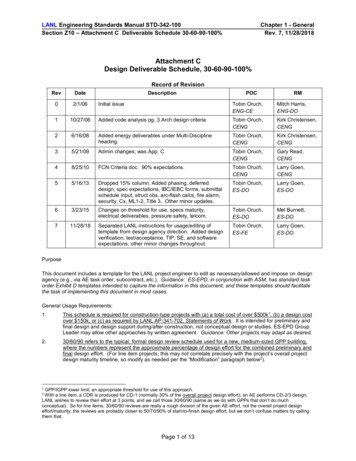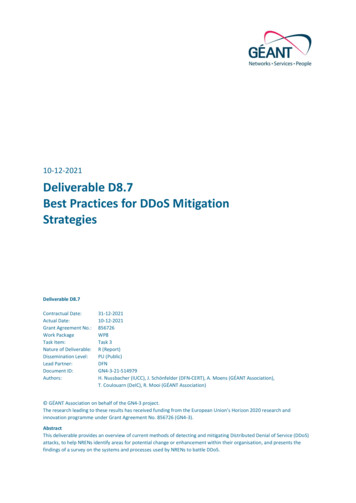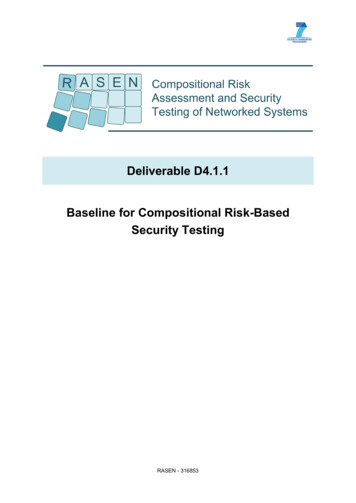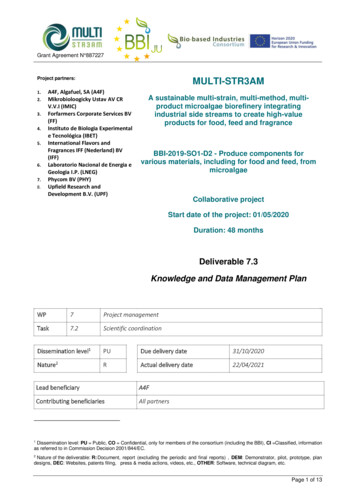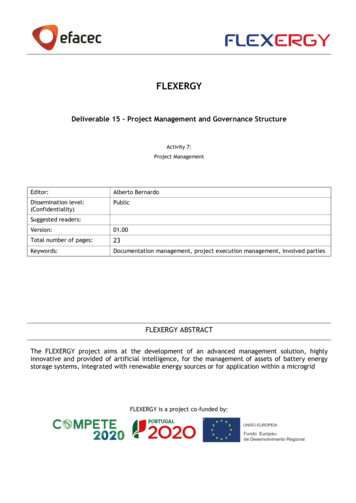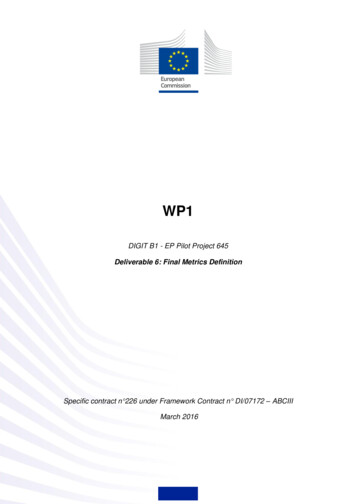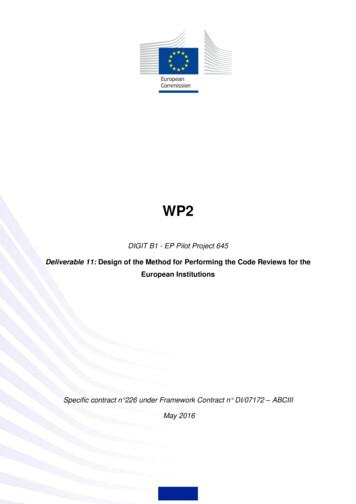
Transcription
Deliverable D4.2.3Techniques for Compositional Risk-BasedSecurity Testing v.3RASEN - 316853
Project title:RASENProject number:316853Call identifier:FP7-ICT-2011-8Objective:ICT-8-1.4 Trustworthy ICTFunding scheme:STREP – Small or medium scale focused research projectWork package:WP4Deliverable number:D4.2.3Nature of deliverable:ReportDissemination level:PUInternal version number:1.0Contractual delivery date:2015-09-30Actual delivery date:2015-09-30Responsible partner:FraunhoferRASEN - 316853Page 2 / 32
ContributorsEditorJürgen Großmann (FOKUS)ContributorsFredrik Seehusen (SINTEF), Fabien Peureux (UFC), Alexandre Vernotte(UFC), Martin Schneider (FOKUS), Johannes Viehmann (FOKUS)Quality assurorsFrank Werner (SAG), Samson Yoseph Esayas (UiO)Version historyVersionDateDescription0.115-06-06ToC proposition0.215-06-06Initial content Fraunhofer FOKUS0.315-09-09Input Testing Dashboard0.415-09-17API and implementation guidelines of Dashboard0.515-09-17Test purpose chapter finalized – overall review1.015-09-25Final versionAbstractWork package 4 has developed a framework for security testing guided by risk assessment. Thisframework, starting from security test patterns and test generation models, allows for a compositionalsecurity testing approach that is able to deal with large-scale networked systems. This deliverable isthe final part of a series of three deliverables (D4.2.1, D4.2.2, D4.2.3) that document how the RASENapproach for risk-based security testing has been evolved through continuous and iterative updates.It provides the final update for the RASEN approach of formalizing test patterns using the TestPurpose Language, and it introduces the RASEN Testing Dash Board for Test Result Aggregation.KeywordsSecurity testing, risk-based security testing, Test Purpose Language, fuzzing on security models,security testing metrics, large-scale networked systems, test selection, test prioritizationRASEN - 316853Page 3 / 32
Executive SummaryThe overall objective of RASEN WP4 is to develop techniques for the use of risk assessment asguidance and basis for security testing, and to develop an approach that supports a systematicaggregation of security testing results by means of security testing metrics. This comprises thedevelopment of a tool-based integrated process for guiding security testing by means of reasonablerisk coverage and probability metrics. This deliverable is the third and final part of a series of threedeliverables that define the overall RASEN approach for risk-based security testing. The earlierdeliverables have introduced approaches for risk-based test identification and selection, the notion oftest pattern, new fuzz testing techniques and the RASEN approach for pattern-driven and modelbased vulnerability testing (PMVT). This deliverables updates the PMVT approach by showing theformalization and operationalization of test patterns using the Test Purpose Language. Moreover, itintroduces metrics that classify test results at the testing level and show their implementation by theRASEN Testing Dashboard. The RASEN Testing Dashboard allows for a concise visualization ofmetric results.RASEN - 316853Page 4 / 32
Table of contentsTABLE OF CONTENTS . 51INTRODUCTION . 62FORMALIZING TEST PATTERNS WITH TEST PURPOSE LANGUAGE . 72.1 EXTENSION OF THE TEST PURPOSE LANGUAGE . 72.1.1Keyword Lists . 92.1.2Iterating the Result of an OCL Expression . 92.1.3Variable Usage in Nested “for each”Loops . 102.1.4Variable Usage in OCL Expressions . 102.1.5Stage Loops . 102.1.6Test Purpose Catalog . 112.2 VULNERABILITY TEST PURPOSES . 112.2.1Cross-Site Scripting. 112.2.2SQL Injections . 132.2.2.12.2.2.22.2.2.32.2.32.2.4Cross-Site Request Forgeries . 16Privilege Escalation . 182.2.4.12.2.4.22.33Error-Based SQL Injections. 13Time Delay SQL Injections . 14Boolean-Based SQL Injections . 15Privilege Escalation of Pages . 18Privilege Escalation of Action . 19SYNTHESIS. 19SECURITY TEST RESULT AGGREGATION . 213.1 LIST UP METRICS . 213.2 COVERAGE METRICS . 223.3 EFFICIENCY METRICS . 243.4 PROCESS/PROGRESS RELATED METRICS . 253.5 THE RASEN TESTING DASHBOARD . 253.5.1Principles . 253.5.2Architecture . 253.5.3GUI. 273.5.4API and Implementation Guidelines . 294SUMMARY . 31REFERENCES . 32RASEN - 316853Page 5 / 32
1 IntroductionThe overall objective of RASEN WP4 is to develop techniques for risk-based security testing. Riskassessment is used to provide guidance and yield as basis for security testing and to develop anapproach that supports a systematic aggregation of security testing results. The objective includes thedevelopment of a tool-based integrated process for guiding security testing by means of reasonablerisk coverage and probability metrics.This deliverable is the third and final deliverable in a series of three deliverables that presentstechniques to address compositional security testing guided by risk assessment. Risk assessment isused to provide a systematic guidance for planning, structuring and organizing the security testingprocess. The overall RASEN approach for risk-based security testing, that defines the Innovation 3 ofthe project, has been described and detailed in the previous deliverable of this series [2]. The processis recalled in Figure 1.Figure 1 – Overall process of security testing based on risk assessment resultsThis process starts with a risk model, a result obtained from the risk assessment that is created byusing the CORAS method from SINTEF. This risk model allows identifying potential threat scenariosand vulnerabilities, and is used for the identification and prioritization of appropriate security testpatterns. Based on the selected security test patterns, test cases are generated by combininginformation from the risk model, a test model and test generation techniques. The latter are composedof test purposes (formalizing the security test patterns) developed by UFC for Smartesting CertifyIt andfuzzing techniques implemented by the Fraunhofer FOKUS’s fuzzing library Fuzzino. Finally, testscripts are generated, compiled and executed against the application under test, and related testresults are gathered and displayed in a Dashboard that provides various security testing metrics.This deliverable focuses on results from the task dealing with automating test execution based on riskassessment in a compositional way and the task to develop metrics and a dashboard for securitytesting results based on risk assessment. In this way, Section 2 provides an update for the RASENapproach of formalizing test pattern using the Test Purpose Language. Section 3 shows metrics thatclassify test results at the testing level and their implementation by the RASEN Testing Dashboard thatallows for a concise visualization of test results and test metric results.RASEN - 316853Page 6 / 32
2 Formalizing Test Patterns with Test Purpose LanguageSecurity test patterns, based on prioritized vulnerabilities from the CORAS model, provide a startingpoint for security test case generation by giving information on how appropriate security test cases canbe created from risk analysis results. The security test patterns express in a textual manner the testingprocedures to detect Web application threats. This way, they propose solutions to improve testingautomation (data vector libraries, test metrics to complete test coverage criteria, etc.). Therefore theyare imported from the risk model elements and then formalized to drive and automate the testgeneration process. To enable automation, the test generation tool CertifyIt proposes a catalogue ofgeneric test purposes that formalize test patterns. To summarize, a test purpose formalizes theintention of a given security test pattern and thus allows to automatically generate the expected testcases with model-based testing techniques.A test purpose is a high-level expression that formalizes a testing objective to drive the automated testgeneration on the test model. As introduced in deliverable D4.2.1 [1], such a test purpose can be seenas a partial algorithm (some steps may be not explicit) defining a sequence of significant steps thathas to be executed by the test case scenario. Each step takes the form of a set of operations orbehaviors to be covered, or specific state to be reached on the test model in order to assess therobustness of the application under test with respect to the related vulnerability to be tested.A typical test purpose is composed of two main entities: iterators and stages. Stages define execution steps (in terms of states to be reached and operations to beexecuted) that the test generation engine must activate. Iterators specify the various contexts within which stages must be activated.Thus, a typical test purpose has the construction introduced inListing 1.for age3.Listing 1 – Test purpose constructionA first version of the syntax and examples of practical use of the test purpose language is described inthe Deliverable D4.2.1 [1] and its grammar is recalled in Figure 2. However, to make generic testpurposes and to formalize complex and sophisticated attacks (required to conduct the RASEN casestudies and thus to validate the proposed approach), this initial version has been extended. The nextsubsections respectively detail these additions and introduce the generic test purposes that formalizethe four vulnerabilities identified during risk assessment of the RASEN case-studies and targeted bytest generation (namely Cross-Site Scripting, SQL Injections, CSRF, and Privilege Escalation).2.1Extension of the Test Purpose LanguageWithin RASEN vulnerability testing approach, a test purpose formalizes the expression of the essenceof a well-understood solution to a recurring software vulnerability testing problem and how it can besolved. To reach this goal, a test purpose captures in a generic way the test pattern part that concernsthe test intention with one or several operational test purposes, in order to automatically produce thecorresponding test cases with model-based testing.Such a test purpose aims to be generic (meaning that it can be applied without update whatever thetest model is) in order to be applied on several models to generate test sequences. However, currenttest purposes contain information coming directly from the current test model, which makes themreliant on it. To avoid any dependence, several additions were made to the test purpose language toallow and improve their genericity.RASEN - 316853Page 7 / 32
Namely, these contributions to the language are the following: Creation of the lists of keywords, referring to model entities, to externalize the use of data; Improvement of “for each” statements to iterate the results of an OCL expression; Addition of variable usage for nested iterators on a set of instances, to use the instanceobtained from the outer iterator as context for the OCL expression of the inner iterator; Addition of variable usage in OCL expressions throughout a test purpose; Introduction of stage loops so that one or several stages can be activated more than once; Creation of a test purpose catalogue that allows automatic import/export of existing testpurposes from one testing project to another.test purposequantifier listquantifieroperation choicecall choicebehavior choiceliteral choiceinstance choiceinteger choicevarstateocl all listcalloperation listoperationparameter listparameterbehavior listbehaviortag listtag:: :: :: :: :: :: :: :: :: :: :: :: :: :: :: :: :: :: :: :: :: :: :: :: :: :: :: :: (quantifier list, )?seqquantifier(,quantifier)*for each behaviorvarfrombehavior choiceforeach operationvarfromoperation choicefor each literalvarfromliteral choicefor each instancevarfrominstance choicefor each integervarfrominteger choicefor each callvarfromcall choiceany operationoperation listany operation butoperation listcall listany behavior to coverbehavior listany behavior butbehavior list identifier (or identifier )*instance(orinstance)*{ number (, number )*} identifier ocl constrainton instanceinstance string identifier bloc(thenbloc)*usecontrolrestriction?target?at least onceany number of time number timesvartimesto reachstateto activatebehaviorto activatevaroperation choicebehavior choicevarcall choicecall(orcall)*instance.operation(parameter list)operation(oroperation)* identifier (parameter(,parameter)*)?free value identifier number varbehavior(orbehavior)*behavior with tagtag listbehavior without tagtag list{tag(,tag)*}@REQ: identifier @AIM: identifier Figure 2 – Grammar of the test purpose languageRASEN - 316853Page 8 / 32
The next sections introduce each of these additions that enable a sufficient expressiveness toformalize generic test purposes targeting the four vulnerability types handled during the RASEN casestudies.2.1.1 Keyword ListsThe keywords mechanism, which has initially been introduced in [1], consists of using specificarguments, called keywords, in test purposes to represent generic artifacts of a test model. They canrepresent behaviors, calls, instances, integers, literals, operations, or a state regarding a specificinstance of the model. Test engineers only have to link keywords with the specific elements of thecurrent test model.Keywords are contained in lists, and a list may only contain keywords that point to elements of thesame nature (behaviors, instances, literals, etc.). Keywords lists can be used both in the iteration andstage phases to replace any of this model information preceded by the character “#”.For instance, considering an enumeration, a keyword list enables to only apply test purposes to literalsof the enumeration that share the same properties or restrictions (e.g., selecting only keywords thatpoint to user actions and excluding unnecessary actions that represent for instance search forms).In theListing 2, the iterator for each goes through all the keywords from the #KEYWORD LIST,each keyword pointing to a certain enumeration literal.for each literal lit from #KEYWORD LISTListing 2 – Literal iteration constructionAs introduced in Listing 3, a test purpose stage can require the test generation engine to call anoperation from a restricted set, or prohibit the call to a given set of operations. This is done as follows:useany operation #RELEVANT OPS to reach OCL EXPR1 on instance inst1useany operation but #UNWANTED OPS to reach OCL EXPR2 on instance inst2Listing 3 – Operation call constructionThe first state expresses to only use any operation that have a corresponding keyword in#RELEVANT OPS. Contrariwise, the second stage expresses to use any operation, except the onesthat have a corresponding keyword in #UNWANTED OPS.2.1.2 Iterating the Result of an OCL ExpressionKeywords lists provide a first level of genericity to test purposes. The use of such lists is necessarywhen the objects they contain must be selected manually. However, when the keywords from a listcan be deduced based on the information from the model, it is thus possible to extract theircorresponding element automatically. Hence the language has been extended to iterate the results ofan OCL expression. It is constructed as shown in Listing 4.for each instance instfrom “self.all users- select(u:User u.att1 2)” on instance User1Listing 4 – OCL result iteration constructionFirst the OCL expression is evaluated, in the context of the User1 instance. The expression returns allUser instances such that att1 is equal to 2. Then, the results are transmitted to the iterator to beused in the stage phase. This construction preserves the generic features of test purposes andautomates the test data selection to be used for test generation.RASEN - 316853Page 9 / 32
2.1.3 Variable Usage in Nested “for each”LoopsCertain types of attack require to consider several data types as well as the relationships betweenthem (e.g., testing for multi-step XSS implies, for a given page, to retrieve all the user inputs that arerendered back on this page). To meet this need, variable usage between for each loops has beenimplemented. In case where the outer loop iterates instances and the inner loop iterates the results ofan OCL expression, it is possible to use the instance from the first loop as the OCL context for thesecond loop as described in Listing 5.for eachinstance inst1from#INST LISTfor eachinstance inst2from“self.all items” on instance inst1Listing 5 – Variable usage in nested iteration constructionIn this example, the outer for each iterates a list of instance. The inner for each is reliant on thevalue coming from its parent as it uses it for defining the context of its OCL expression. Thereby, theself variable from the OCL expression corresponds to inst1.Usage of data-dependent nested loops is for instance necessary to compute abstract test cases formulti-step XSS, as it avoids the production of unreachable targets.2.1.4 Variable Usage in OCL ExpressionsIn more sophisticated attacks, data dependency goes beyond their selection and must be carriedthroughout the test purpose. For instance, Privilege Escalation attacks involve session types, pages,and their relations, in order to test that access control policies are not flawed. In these cases, it needsto use the value from the iterator to configure OCL expressions in order to make test purposes moreprecise and avoid the submission of irrelevant or unreachable test targets to the test generationengine. As introduced in Listing 6, variables can be used in the iteration phase in cases of nestedfor each statements, thus:for each literal lit from #LITERAL LISTfor each instance instfrom “self.all users- select(u:User u.att1 2)” on instance User1Listing 6 – Variable usage in OCL expressions within nested iterationMoreover, variables can also be used in OCL expressions from the restriction part of stages as shownin Listing 7useany operationto reach “self.status STATUS:: lit” on instance SUTListing 7 – Variable usage in OCL expressions within stagesThis stage expresses that any operation from the model can be used, with the goal that the statusattribute from the system under test is valuated with the content of lit, which contains anenumeration literal from the enumeration STATUS.2.1.5 Stage LoopsIn some cases, it is necessary to reproduce the exact same set of steps several times, in order toconduct an attack. This is the case especially for time-based and Boolean-based SQL injections,which require the injection of several vectors in the same user input and compare the results.To make the design of such test purpose simpler while reducing test generation time, the notion ofstage loops has been introduced in the test purpose language. As introduced in Listing 8, stage loopsare defined using the declaration keyword repeat, followed by a integer and the keyword times,expressing the number of loop to accomplish:RASEN - 316853Page 10 / 32
repeat 3 timesuse thenuse.end repeatListing 8 – Stage loop constructionIn this sequence, the stages “use.” enclosed in the loop must be repeated three times.2.1.6 Test Purpose CatalogTest purposes are stored in a test purpose catalogue (in XML format), with a reference to the pattern itbelongs to. Within the RASEN project, test purpose selection is directly conducted based on a riskassessment: regarding the information present in the CORAS model, the corresponding test purposesare chosen for test generation. It should be noted that test engineers can also manually select relevanttest purposes to be applied, depending on the test objective or motivated by a test selection criteria.2.2Vulnerability Test PurposesThis section introduces the generic test purposes designed during the RASEN project to tackle thefour vulnerabilities targeted during the conducted case studies (Cross-Site Scripting, SQL Injections,CSRF, and Privilege Escalation). Some vulnerability required the design of several test purposeswhen the implementation of multiple attack subcategories was necessary for efficient testing (e.g., forSQL injections and Privilege Escalation). For each test purpose, we first present the test purpose usedto design it, and describe next its functionality by going through each of its steps.2.2.1 Cross-Site ScriptingCross-Site Scripting vulnerability (XSS for short) consists of an attacker injecting a hostile browserexecutable code (e.g., JavaScript, VBScript) into Web pages through user inputs, typically Web forms,or through parameters, which value can be modified by clients, such as cookie values. Thisvulnerability type is one of the consequences due to the lack of proper user-supplied input dataanalysis from the web application under test.As stated in the XSS test pattern, it is possible to perform XSS attack by applying the following testingstrategy that is composed of three steps: (i) locate a user-supplied input, (ii) inject an XSS vector, and(iii) analyze the server response. However, to tackle all XSS types at once, the XSS test purposemakes use of the structure information that is specified in the model: links between user-suppliedinputs and the pages of the Web application under test that use them to compute an output. Thereby,for the testing of a particular user input, the test purpose for XSS proceeds as follows:1. Locate the user input: Following proper user interactions, the Web application is put in astate where the current page is the page where the user input can be provided. It can be aform field, a parameter in the “href” attribute of an anchor, a cookie value, etc.2. Fill nominal values: Often, the user input under test is part of a form or URL, which containsmultiple parameters. These parameters need to be assigned with relevant values to preventany data validation functions (e.g., some parameter must not be left empty, or must be onlyassigned with a specific data type) to block the submission of the form/request.3. Replace input with attack vector: Here, the initial nominal content of the user input undertest is erased and an attack vector is injected instead.4. Submit the crafted request: Once the attack vector has been inserted, the crafted request issubmitted. Depending on the type of user input, it means submitting the form, or clicking onthe link.5. Locate an output point: Instead of simply waiting for the next server response, the testmodel is used to determine which page uses the user input under test to compute its output,and the Web application state is changed such that it displays the page.RASEN - 316853Page 11 / 32
6. Analyze the result: The content of the page is then analyzed to assess whether the attackvector has been inserted in the page. If it has not undergone any modification, it can beconcluded that the Web application is vulnerable to XSS, from this particular user input and onthis particular page.This test procedure has been translated into a test purpose in order to give each instruction to the testgeneration engine from Smartesting. The test purpose for multi-step XSS is shown in Listing 9.123456789101112for eachinstance pagefrom"self.all pages- select(p:Page not(p.all outputs- isEmpty())" on instancewas,for eachinstance paramfrom"self.all outputs"on instance page,useany operation but#UNWANTED OPSany number of timesto reach"WebAppStructure.allInstances()- any(true).ongoingAction.all inputs- exists(d:Data d self))"on instance paramthenusethreat.injectXSS( param)thenusewas.finalizeAction()thenuseany operation but#UNWANTED OPSany number of timesto reach"self.was p.current page selfandself.was p.ongoingAction.oclIsUndefined()" on instance pagethenusethreat.checkXSS()Listing 9 – Test purpose for cross-site scriptingThe first three lines of the test purpose for XSS compose the first phase. Because this is about XSS,the first for each statement selects all the pages that are using at least one user input as ages.allInstances() select(p:Page not(p.all outputs- isEmpty()))” executed from the context of the SUTinstance, that defines the Web application under test. This OCL expression can be split as follows:from all the pages “Pages.allInstances()”, all the pages “- select(p:Page ” that are linked toone or more data instances “not(p.all outputs- isEmpty())” are selected. The result of theOCL expression is a set of page instances.Afterwards the for each statement selects all the data instances linked to the page instancecontained in page, i.e. all the user inputs that page uses to compute its output. Here, the selection isdone using the OCL expression “self.all ouputs” from the context of page. Therefore, thesecond stage of the test purpose handles two elements, a user input and one of the pages thatoutputs it.The second phase starts on lines 4-5-6 by putting the Web application in a state where the pagedisplayed to the user is the injection page, and where the action containing param is ongoing,meaning all other fields (in the case of a form) or parameters (in the case of a link) have been filledwith nominal values, ready to be submitted. In the context of the selected user input (“on instance param”), the test purpose tells the test generation engine to satisfy the OCL expression“WebAppStructure.allInstances()- any(true).ongoingAction.all inputs exists(d:data d self)”. First, the instance of the Web application under test is retrieved“WebAppStructure.allInstances()- any(true)”. Second, we navigate in the model until theongoing action “ongoingAction” is reached. Third, one check that the user input param iscontained in the action “all inputs- exists(d:data data self)”.To satisfy this expression, the test generation engine must animate the model by executing theinstructions “use any operation but #UNWANTED OPS any number of times”, whichmeans that any behavioral or navigational operation from the Web application can be called, as manytimes as needed, in order to find the right state. Indeed, each designed test purpose possesses akeyword list, named #UNWANTED OPS, which contains all the operations from the WebAppStructureclasses except those to exercise an attack. Those operations are not meant to be called during thecomputation of navigational and beha
results are gathered and displayed in a Dashboard that provides various security testing metrics. This deliverable focuses on results from the task dealing with automating test execution based on risk assessment in a compositional way and the task to develop metrics and a dashboard for security testing results based on risk assessment.

